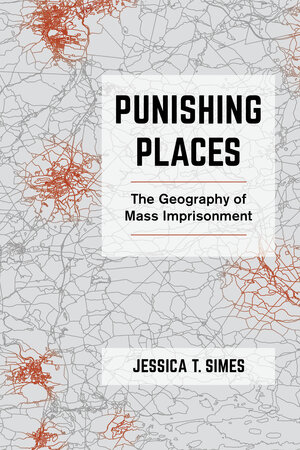By Jessica T. Simes, author of Punishing Places: The Geography of Mass Imprisonment
Despite growing attention to the problem of mass incarceration, we are still only beginning to capture its far-reaching harms. Scholars and activists have revealed mass incarceration’s impact on the individuals targeted for punishment — but what about their families, communities, and neighborhoods? The community members who are left behind experience loss each time a person is incarcerated. How do we make sense of the scale of community loss from incarceration?
My new book, Punishing Places: The Geography of Mass Imprisonment, charts and maps new ways of understanding how public policy has punished whole neighborhoods and communities. I operationalize community loss by calculating the cumulative number of years individuals are sentenced to jail or prison. Time spent incarcerated and out of the community captures the collective and cumulative experience of loss in communities. I draw a parallel to the public health measure of premature death, measured in the years of potential life lost, which is the difference between age at actual death and expected mortality.
The results are staggering. For example, Massachusetts, a state with one of the lowest incarceration rates in the U.S., still managed to sentence people to a minimum of 127,000 years in just 13 years of its period of mass incarceration (1997-2009). Boston neighborhoods alone lost over 28,000 years to prison — time that could have been spent working or attaining post-graduate degrees. Black and Latinx neighborhoods experienced the greatest levels of community loss in the state. A single Black neighborhood experienced over 800 years of community loss, and a Latinx neighborhood experienced nearly 1,000 years of loss during this same time period.
This loss of time is unfathomable by any population or historical standard. But beyond how incarcerated individuals experience it, this loss permeates throughout communities — affecting networks, households, and neighborhoods.
In this way, mass incarceration is a social process in which large numbers of people living in close proximity suffer multiple and persistent losses. The idea that loss can be felt collectively—at the community level—has roots in the health literature on grief and stress. Specifically, the concept of ambiguous loss applies to the case of incarceration. Not knowing whether a missing person will ever come back creates chronic, ambient stress. These losses are compounded by hostile, disapproving, stigmatizing, and indifferent social attitudes about the loss of a family member to incarceration.
Loss in communities of pervasive incarceration impacts social cohesion and engenders a sense of legal estrangement, placing the police and courts, as well as social services, at a disadvantage; these services operate best with strong community support and investment. Community losses also yield significant economic and political costs, as large numbers of prime-age men and women cannot contribute to the neighborhood or community’s economic viability. Political participation is suppressed by excluding most incarcerated people from democratic participation and even from population counts used for redistricting purposes. For community members left behind, these hidden and unacknowledged losses can complicate mourning and impede access to social and financial supports during the separation caused by incarceration. Thus, community loss represents a fracturing of communities: a break in the bonds of society, creating additional hardships for the most marginalized.
Social theorist Irving Goffman once said of total institutions and their impacts that “whether a particular total institution acts as a good or bad force in civil society, force it will have, and this will in part depend on the suppression of a whole circle of actual or potential households.” We can debate whether these losses are wholly negative for community members who may have experienced harm by those incarcerated. But what is clear is that a significant loss of time and population has attended mass incarceration, following deliberate policy choices — and this loss is unequally distributed across places by race and class.
The United States has been under an era of mass incarceration for decades, and while punishment is premised on the individual, it has been directed at whole communities. To understand mass imprisonment and its effects we cannot only look at people who have entered the prison system — we must also examine the broader community-level impacts and inequities of the system. Yet in Sociology, our measures tend to only describe particular conditions and social problems as counts, rates, or ratios in a given geographic space. In Punishing Places, I propose a new set of measures for reconceptualizing the community-level conditions of mass imprisonment to fully capture its broad social and political effects.

